The Gigabyte P35X v3 Review: Slim GTX980M Gaming Laptop
by Brett Howse on April 23, 2015 8:00 AM ESTBattery Life
The P35X comes with a 75 Wh battery, which is fairly large by today’s standards. However there is a lot of performance under the keyboard, so battery life is always going to be the trade-off on a system like this. I think people that buy these systems generally expect that they will likely need to be plugged in for most tasks, but if you ever do need some mobility, it should be there.
To test battery life, we have two tests. The first is just a browsing test, and the heavier test ramps up the number of pages loaded, adds a movie, and has a 1 MB/s file download running for the duration. As always, we standardize our battery life tests with a display brightness of 200 nits so as not to penalize devices like the P35X which have a very bright display.
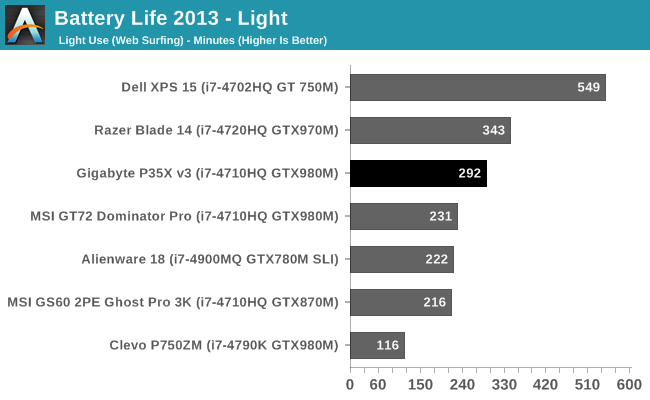
The P35X is not going to set any records for battery life, but for a gaming system, almost five hours is fairly respectable. It is almost an hour behind the Razer Blade in this test despite the larger battery in the P35X, but it does well compared to the other gaming systems in our database.
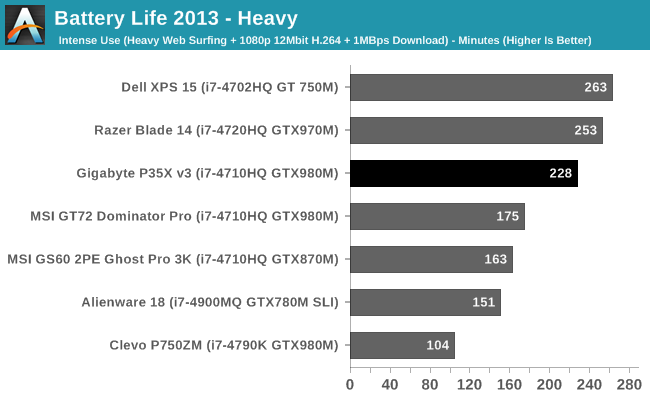
Once again the P35X falls victim to the impressive battery life of the Razer Blade, but it does hold its own when compared to the rest of the gaming notebook competition. While I would not go so far as to say the P35X has good battery life, for what it is, it is reasonable. But clearly Razer has put more work into a more efficient platform overall. We can check that out by removing the battery size from the equation in our normalized graphs.
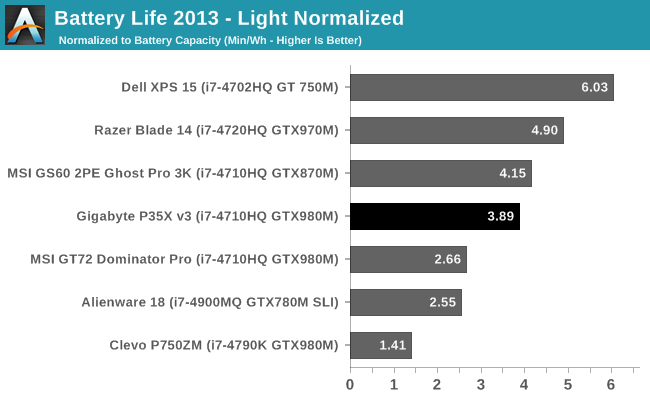
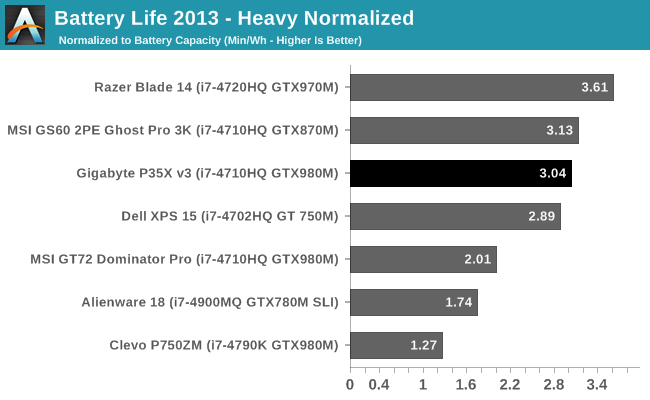
The normalized graphs show the extent of Razer’s power optimizations, because even with a higher resolution display and smaller battery, it has better battery life than the other gaming systems. But putting that one device aside, the P35X does well against the other competition. They could do better though, and this is one of the things where having multiple drives in RAID can really hurt.
Charge Time
The other aspect to mobility is charge time. Gigabyte includes a rather large 180 watt power adapter, but of course much of that is to power the system when it is operating at maximum. Although more of the adapter could be routed to the battery, there needs to be enough available to keep the device running at maximum power.
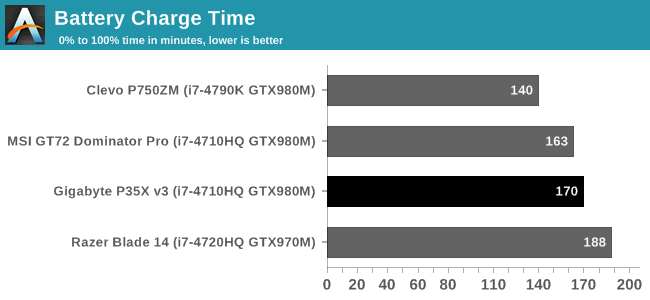
At 170 minutes, the P35X is certainly not the fastest device to charge, but considering the larger than average battery it is not too bad.
95% charge takes about two hours, and the last 5% takes almost another full hour. If you were on the go, 50% charge is less than an hour, which is not too bad.
Overall, the P35X can be a mobile device, but as compared to other mobile devices of 2015, it is far from ideal. For these types of systems, I think the target market really is looking for portable rather than mobile, and the P35X is more portable than most gaming systems around. It does like to stay close to an electrical outlet, but for gaming, that is almost a necessity anyway despite the efforts to reduce the power consumption of GPUs.
Wi-Fi
Gigabyte has opted for the Intel Dual Band Wireless-AC 7260 wireless adapter, which is very familiar at this point. It offers a maximum connection speed of 866 Mbps from its 2x2:2 802.11ac capabilities. It has been a strong performer in the past, and while not the outright fastest 802.11ac adapter around, it still offers good performance.

400 Mbps seems to be about the average for this adapter, and the Gigabyte hits that. Speeds are good, and while some devices are faster, there is little to complain about here.


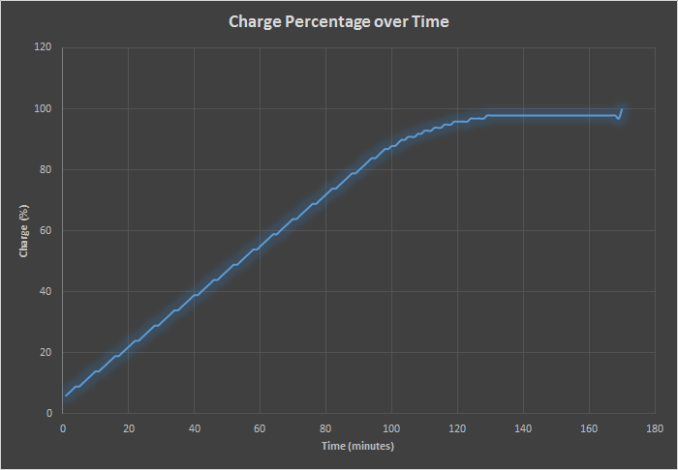








55 Comments
View All Comments
Darkstone - Thursday, April 23, 2015 - link
If a 17" gaming rig throttles, than i suggest sending it back to wherever it came from. These systems are build for maximum performance, and i expect no less of them. Do not forget that the situation grows worse over time when the system builds up dust.I'm honestly amazed that throtteling is seen as even remotely acceptable. All the manufacturer has to do is follow the TDP guidelines of the components in question. If they pair an 45W CPU with cooling specced for 35W, its their fault.
nerd1 - Friday, April 24, 2015 - link
Now most systems throttle under 100% CPU and GPU load because a) people want slimmer and lighter machine b) typical gaming scenario are not that demanding. Most games are developed for multi-platform and consoles are notorious for having crappy CPU power.wykd - Friday, April 24, 2015 - link
Go play some GTA5 and take a look at CPU usage. It will easily max out all cores on my i5-3570k.xKrNMBoYx - Monday, April 27, 2015 - link
That's one game and so far it seems to happen to CPUs that have only 4-Threads. The game seems to use more than 4 threads a bit better than older games plus the game did put some serious load on CPUs (which was supposedly fixed with a patch) but wasn't as much of a problem with CPUs with more threads.Kutark - Tuesday, April 28, 2015 - link
Agreed. Honestly if you're looking for that level of gaming in a notebook you should be looking at the 8-10lb 1-2" thick ones, you're basically using it as a desktop replacement at that point. Going for a super thin notebook with top end hardware is a recipe for disaster as far as thermals.Hell i have a ~1" thick 17" with an 860m and it will occasionally throttle, and it has a very well designed cooling system.
Whats the point of having a superbadass CPU/GPU if its throttling it every time you load a game up.
Thats like having a Porsche that limits you to only 5 seconds of 100% throttle then backs it down to 60% throttle because of heating issues. Nobody in their right mind would buy a porsche that can't perform at the tops of its game all the time.
DCide - Thursday, April 23, 2015 - link
Your statement looks weird to my ears.Ikas - Sunday, May 3, 2015 - link
It truly is a shame such a great overall package is ruined by the extremely loud fans, sure gaming laptops run hot and loud but this takes it to a whole other level.kyuu - Thursday, April 23, 2015 - link
Why do you need to use more than one game to test the thermals?meacupla - Thursday, April 23, 2015 - link
I, for one, wouldn't mind trading off battery size for better and quieter cooling in a system like this.If I had one of these, most likely, I'm just going to play games on it when it's hooked up to a wall outlet, so I really don't see much point in having good battery life over better cooling and acoustics.
nikaldro - Thursday, April 23, 2015 - link
Then just buy a desktop AND a low power notebook?